Yoga, with its roots deeply embedded in ancient Indian traditions, has now become a global phenomenon. Incorporating yoga into your daily routine can be quite challenging, but the growing celebration of yoga has made it more prominent among people. World Yoga Day, celebrated on June 21, is an ideal opportunity to learn new yoga asanas and understand the importance of daily practice.
However, when you’re practicing yoga and meditation, having a dedicated yoga room becomes important as it positively impacts your state of mind. The decor of a yoga room is a crucial aspect of its design, as it sets the tone for the practice. Walking into a yoga studio, the ambiance attracts you instantly. Whether it’s natural or soft lighting, the fragrance of burning incense or scented candles, eye-catching rugs, or the warm glow of Himalayan salt lamps, your mind is immediately at peace.
And,Yoga Decor from India is one fascinating aspect is how yoga studios, particularly in the West, have embraced Indian textiles and decor. So, let’s explore the significance of Indian decor in yoga studios, its cultural implications, and the intricate designs that make it unique.
Indian Decor: A Blend of Tradition and Aesthetics
Indian decor is renowned for its vibrant colors, intricate patterns, and a profound sense of artistry. The incorporation of these elements into yoga studios is not merely a matter of aesthetics but also a nod to the origins of yoga. Here are few Indian decor items you can incorporate in your yoga studios:
Mandala Artwork
Mandalas have a history that goes back thousands of years, especially in Eastern religions like Hinduism and Buddhism. They are used as spiritual tools to help with meditation and entering a trance state. Tibetan monks, for instance, create intricate sand mandalas, which they carefully craft and then ceremoniously dismantle to remind us of life’s impermanence.
In these traditions, a mandala represents a sacred space, like a miniature universe seen from a human perspective. Each mandala is unique and typically has a central point, called the bindu, surrounded by geometric shapes and symbols. This central point is where meditation begins, helping to focus the mind on the spiritual journey.

Antique Indian Carved Doors
Antique Indian carved doors are a beautiful addition to a holistic yoga sanctuary. These doors, often adorned with carvings inspired by temple art, feature Hindu deities like Krishna, Shiva, Ganesha, and Buddha. Their presence brings a sense of harmony and tranquility to the space.
Walking into a yoga studio decorated with these antique doors feels like stepping back into ancient India, surrounded by rich cultural heritage and spiritual significance. Each door is crafted from reclaimed wood and showcases intricate carvings that tell stories from Indian folklore and mythology. These designs are not just decorative; they are artful representations filled with meaning, created by skilled artisans who infused them with devotion.
Inspired by the grand architecture of Indian havelis, these doors add a touch of old-world elegance to any space. Their nature-inspired designs and elaborate patterns, reminiscent of temple doors, help yoga practitioners leave behind the chaos of daily life and focus on their journey of self-discovery and inner peace.
Beyond their aesthetic beauty, these carved doors contribute to the spiritual energy of a yoga studio or meditation room. They help create a cohesive atmosphere that supports balancing chakras and energizing kundalini energy, making each practice more meaningful. For instance:
- Ganesha: Known as the lord of the root chakra, Ganesha helps connect you to the earth and represents the foundation of everything. This chakra is where the kundalini energy resides, grounding you and giving you a strong start.

- Krishna: Krishna rules the heart chakra, or the love chakra, helping maintain a balance between creation and action. His influence nurtures love and compassion, keeping your heart open and aligned.

- Shiva: As the Adiyogi, Shiva governs the throat chakra, where your thoughts are transformed into actions. Shiva supports and sustains the power of your words and expressions, guiding your communication and self-expression.
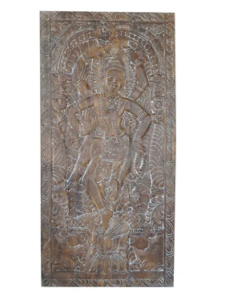 This shows that decorating your yoga studio with antique Indian carved doors is more than just a design choice—it’s a way to appreciate the rich tradition,artistry, and spiritualism of India.
This shows that decorating your yoga studio with antique Indian carved doors is more than just a design choice—it’s a way to appreciate the rich tradition,artistry, and spiritualism of India.
Traditional Indian Textiles
Indian textiles, with their diverse range of fabrics, designs, and techniques, offer a plethora of options for decorating yoga studios. Some popular choices include:
Yoga Mats and Rugs
Many yoga studios offer mats inspired by Indian textiles, incorporating the rich visual traditions of Indian art into the very fabric of their practice spaces. These mats often feature intricate designs such as mandalas, paisley patterns, and other motifs that are deeply rooted in Indian culture. The detailed mandala designs, for instance, are not just visually captivating but also hold significant spiritual meaning, aiding in meditation and focus.
In addition to these specially designed mats, some studios take their commitment to authenticity a step further by using traditional Indian dhurrie rugs. Dhurrie rugs are flat-woven from cotton or wool and are known for their vibrant geometric patterns and durability. Unlike conventional yoga mats, these rugs offer a unique, textured surface that enhances the tactile experience of yoga practice. The natural materials used in dhurries provide a comfortable and sturdy surface, making them a great alternative to modern synthetic mats.
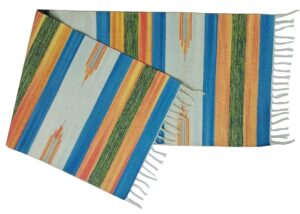
Incorporating these traditional elements into yoga studios does more than just enhance the aesthetic appeal. It creates a space that honors the cultural origins of yoga, providing practitioners with a deeper connection to the practice. The authentic touch of dhurrie rugs, in particular, adds a sense of warmth and history, making each yoga session feel like a journey through time and tradition.
Cushions and Bolsters
Cushions and bolsters are essential props in yoga and meditation practices, providing comfort and support during long sessions. Many studios enhance their ambiance by covering these items in fabrics inspired by Indian textiles. These might include:
- Khadi Fabrics: Khadi is a hand-spun and hand-woven fabric that gained prominence during India’s independence movement, led by Mahatma Gandhi. Known for its simplicity and natural texture, Khadi embodies principles of mindfulness and sustainability. Cushions and bolsters covered in Khadi fabric offer a rustic and earthy feel, creating a grounded and serene atmosphere in the yoga studio.
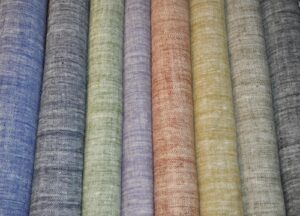
- Block-printed Cottons: This traditional technique involves stamping repetitive patterns onto the fabric using carved wooden blocks. The result is a fabric with a unique, handcrafted look, often featuring vibrant colors and intricate designs. Block-printed cottons are not only visually appealing but also breathable and comfortable, making them ideal for meditation cushions and bolsters. The repetitive patterns can also have a calming effect, helping practitioners to relax and focus during their sessions.
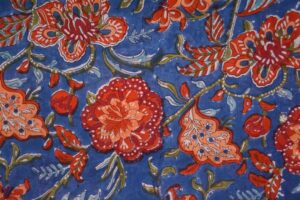
- Kalamkari Fabrics: Kalamkari is an ancient Indian art form that involves hand-painting or block-printing on fabric. The designs often depict mythological themes and natural motifs, making them perfect for meditation cushions and bolsters. Kalamkari fabrics are known for their intricate detail and vibrant colors, adding a unique and artistic touch to any yoga studio. The storytelling aspect of Kalamkari can also inspire a deeper connection to the practice and the cultural roots of yoga.
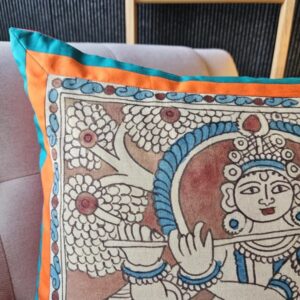
Cotton Clothing
Handloom cotton is a staple in Indian textiles, known for its breathability, softness, and durability. Perfect for yoga clothing, handloom cotton ensures comfort during intense practice sessions by allowing the skin to breathe and wicking away moisture.Traditional handloom fabrics, often adorned with subtle patterns and earthy colors, add a rustic and authentic feel to yoga attire.
Cultural Appropriation
While the incorporation of Indian textiles and decor in yoga studios is a beautiful homage to the origins of yoga, it is crucial to navigate the fine line between appreciation and appropriation.
Understanding Cultural Appropriation
Cultural appropriation involves taking elements from a culture without understanding or respecting their significance, often leading to misrepresentation and exploitation. In the context of yoga studios, this can occur when Indian decor is used superficially, without acknowledging its cultural and historical context.
Practicing Cultural Sensitivity
To avoid cultural appropriation, it is essential for yoga studio owners and practitioners to educate themselves about the cultural significance of the decor they are using. This can involve:
- Learning the History: Understanding the origins and meanings behind Indian textiles and decor can foster a deeper appreciation and respectful use of these elements.
- Supporting Local Artisans: Purchasing decor items directly from Indian artisans or fair-trade organizations ensures that the creators are fairly compensated and their craft is respected.
- Incorporating Authenticity: Rather than using Indian decor as mere ornaments, integrating them into the studio’s philosophy and practice can create a more authentic and respectful environment.
Conclusion
Incorporating Indian textiles and decor into yoga studios is more than a design choice; it is a way to honor the rich cultural heritage of yoga. By thoughtfully selecting and integrating these elements, yoga studios can create a serene and authentic environment that enhances the overall experience for practitioners.
It is important, however, to approach this integration with sensitivity and respect, ensuring that the cultural significance of these items is acknowledged and appreciated. By doing so, yoga studios can truly embody the spirit of yoga – a practice that connects us not only to our inner selves but also to the rich tapestry of traditions and cultures that shape our world.
Whether you are a yoga studio owner, practitioner, or someone interested in the cultural aspects of yoga, embracing the beauty and significance of Indian textiles and decor can deepen your connection to this ancient practice and create a space that is both inspiring and nurturing.
- Khadi Fabrics: Khadi is a hand-spun and hand-woven fabric that gained prominence during India’s independence movement, led by Mahatma Gandhi. Known for its simplicity and natural texture, Khadi embodies principles of mindfulness and sustainability. Cushions and bolsters covered in Khadi fabric offer a rustic and earthy feel, creating a grounded and serene atmosphere in the yoga studio.

